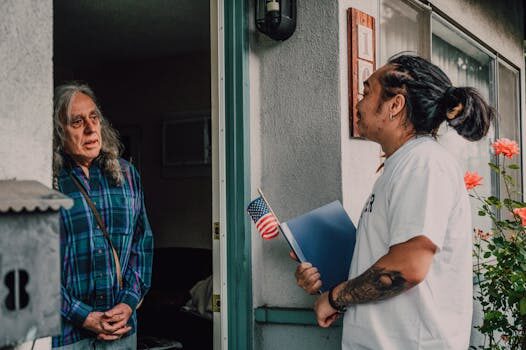Saying hello and goodbye in Polish: a complete guide

Learning the local language is the first step towards immersing yourself in the culture and customs of a new country. For those venturing into Poland or interacting with Polish speakers, mastering the art of saying hello and goodbye in Polish is essential. These greetings are not just words but a gateway to connecting with people and showing respect for the Polish culture.
Understanding basic Polish greetings and farewells
Polish greetings and farewells can be an intriguing blend of formality, warmth, and tradition. They are a critical component of daily interactions and vary depending on the time of day and the relationship between speakers. Learning these expressions can significantly improve your language proficiency and the ease with which you navigate social situations.
Beginning with simple phrases such as Cześć for "hello" or Dzień dobry for "good morning," can make a strong first impression. As the day progresses, Dobranoc, meaning "good night," is a common farewell. These phrases are essential for anyone looking to engage in basic communication in Poland.
The importance of saying hello and goodbye in Polish
Polish people value politeness and proper etiquette, which is why understanding the significance of greetings and farewells is crucial. These expressions are more than mere pleasantries; they reflect your respect for Polish culture and your efforts to integrate into the local environment. A proper greeting can open doors and build rapport, while a respectful farewell can leave a lasting positive impression.
By recognizing the importance of these simple phrases, you not only show linguistic competence but also cultural sensitivity, which is highly appreciated in Poland.

How to say hello in Polish: Essential phrases
When it comes to saying hello in Polish, there are several key phrases to know:
- Cześć - Hi/Hello (informal)
- Dzień dobry - Good morning/Good afternoon (formal)
- Witaj - Welcome (can be formal or informal)
- Siema - Hi/Hello (very informal, slang)
These greetings are just a starting point, but they are instrumental for beginners to feel confident in initiating conversations with Polish speakers.
What are the formal ways to say goodbye in Polish?
When parting ways, especially in formal settings or with individuals you're not well-acquainted with, it is polite to use formal goodbyes. Some of the common formal ways to say goodbye in Polish include:
- Do widzenia - Goodbye
- Do zobaczenia - See you (literally means "till seeing")
- Do usłyszenia - Bye (on the phone, literally means "till hearing")
- Żegnaj - Farewell (a bit old-fashioned, can sound very formal)
Using these phrases appropriately will convey respect and professionalism in various contexts.

Informal ways to say goodbye in Polish: A quick guide
With friends, family, or close colleagues, informal goodbyes are more appropriate. They convey warmth and familiarity and can vary widely in Polish. Here are some examples:
- Na razie - See you (informal)
- Pa - Bye (very informal)
- Cześć - Bye (can be used as both hello and goodbye informally)
- Trzymaj się - Take care (informal)
Such parting words can end conversations on a friendly note and strengthen social bonds.
Unique Polish greetings for different occasions
Poland is a country with strong traditions and seasonal greetings that are unique to specific holidays and occasions. For instance:
- Wesołych Świąt - Merry Christmas
- Szczęśliwego Nowego Roku - Happy New Year
- Wszystkiego najlepszego - All the best (for birthdays or celebrations)
Recognizing and using these greetings during the right occasions can show a deeper understanding and appreciation of Polish customs.

Practicing Polish greetings and farewells in daily life
Incorporating Polish greetings and farewells into your daily routine is a practical way to enhance your language skills. Practice with native speakers, listen to authentic dialogues, and repeat phrases aloud to improve pronunciation. Remember, practice is key to language proficiency.
One excellent way to hear these phrases in use is through online resources. For example, this video:
Saying hello and goodbye in Polish: Further explorations
What is Polish for hello and goodbye?
In Polish, "hello" can be translated to "Cześć" or "Dzień dobry," while "goodbye" is often said as "Do widzenia." These expressions are fundamental when engaging in polite and courteous conversations.

Each phrase has a proper context of use, with "Cześć" being more casual and "Do widzenia" more formal. Understanding when to use each can greatly influence the tone of your interactions.
What is the Polish goodbye?
The standard Polish goodbye in formal situations is "Do widzenia." However, in informal settings, phrases like "Na razie" or simply "Cześć" are more commonly used.
It's interesting to note that "Do widzenia" literally means "until seeing," implying that you hope to see the person again. This carries a nuanced meaning and reflects the positive spirit of Polish interactions.
What is a typical Polish greeting?
A typical Polish greeting during the day would be "Dzień dobry," which is suitable for most formal and semi-formal situations. Among friends and younger people, "Cześć" is widely used and carries a friendly undertone.

These greetings are the backbone of daily communication in Poland and are often accompanied by a handshake or, in more familiar situations, a hug or kisses on the cheeks.
Do you say goodbye in Polish?
Yes, expressing goodbye in Polish is important and can vary depending on the scenario. "Do widzenia" is the go-to phrase for formal situations, while "Na razie" or "Pa" work well informally.
Using the correct form of goodbye shows respect for the person you are speaking with and acknowledges the end of the conversation in a polite manner.

Leave a Reply